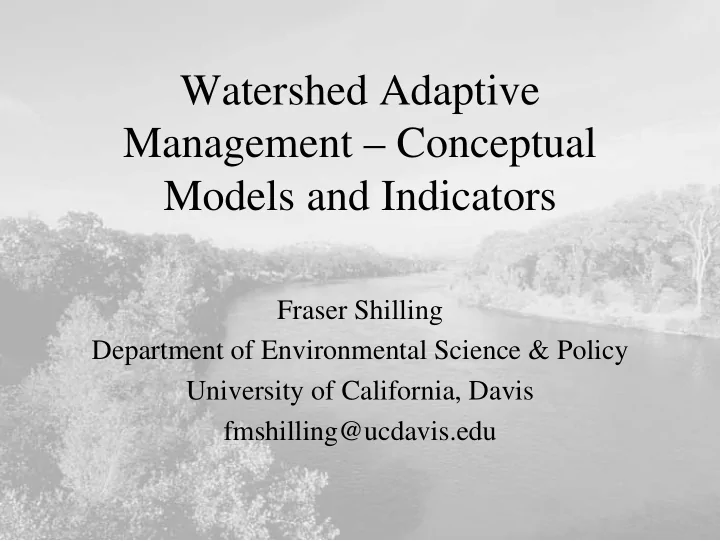

Watershed Adaptive Management – Conceptual Models and Indicators Fraser Shilling Department of Environmental Science & Policy University of California, Davis fmshilling@ucdavis.edu
Watershed Adaptive Management • Watershed assessment – Scoping and question formulation – Basic description • Watershed management – What can we influence – Conceptual modeling – Select environmental and management indicators
What is Adaptive Watershed Management? • The process of 1) designing management so that effects and effectiveness can be evaluated and 2) using assessment of prior management actions to inform future management decisions. • In watersheds, it is important to develop a picture of how the parts and processes operate together and what influences those operations.
Watershed Adaptive Management • Watershed assessment – Scoping and question formulation – Basic description • Watershed management – What can we influence – Conceptual modeling – Select environmental and management indicators
What is a conceptual model? • A diagrammatic or narrative representation of how a system works • A visual model representing causal relationships • Comes in many forms A conceptual model of the nitrogen cycle
Influence diagrams and conceptual models Boxes indicate concepts and arrows indicate influence or connection. The boxes can be attributes or processes, the arrows can be hypotheses, or based on knowledge of the system
Key components of a model Focus or Focus or The part of the system about which you, the Issue Issue conceptual modeler, is most concerned Affected Affected Natural or human-origin processes (e.g., climate cycles, flow rates) or attributes (e.g., geomorphology) Processes or Processes or Attributes Attributes that are altered. Natural or human factors, such as farming, dams, In Influences fluences urban development, off-road vehicle use, that or Causes or Causes produce the altered conditions/processes
1. Begin by formulating your questions or issue of concern • What do you care about? – Decline in a species of concern – Loss of riparian habitat and associated recreational opportunities – Loss of groundwater recharge – Increase in the number or extent of algal blooms – Increase in the distribution of invasive plants – Loss of fishability due to mercury contamination
2. Consider the things that might affect the issue of concern…. In one example, salmon population. Examples for salmon: • Increased fines in spawning gravel • High water temperatures • Reduced flows • Increased predation of young • Loss of canopy cover
3. Consider the causes, drivers, or sources of these alterations on conditions/processes • Logging • Grazing • New housing development • Industrial activity • Roads • Climate change
Sample Conceptual Model Agriculture Geothermal Springs Nutrients Abandoned Mines Bacteria & Algal growth Methyl- Sediment Hg in Fish mercury Boxes indicate watershed conditions and processes, arrows indicate possible influences and connections. Starting with the issue of “Hg in fish” you can work backwards to find the natural and human influences and contributors to this problem.
Ecosystem Attribute Conceptual Model General Reid and Zeimer
Building an ecosystem-based conceptual model Logging Causes Grazing Urbanization Increased erosion Influences Altered spawning gravel Focus Disappearing (Issue) Salmon Reid & Ziemer, 1996
Ecosystem Restoration Conceptual Model Action- Specific
Ecosystem Attribute Conceptual Model Policy nexus Reid and Zeimer
Ecosystem Attribute Conceptual Model Endangered Species Act, SWRCB Policy nexus permits, THPs, CEQA, ACE 404 Endangered Species Endangered Species Act, FERC re- Act, Federal Fisheries licensing, SWRCB statutes, Int’l treaties permits, ACE 404
Watershed Adaptive Management • Watershed assessment – Scoping and question formulation – Basic description • Watershed management – What can we influence – Conceptual modeling – Select environmental and management indicators
Selecting Indicators • “An environmental indicator is a discreet measure of one aspect of environmental quality that can be used alone or in combination with other indicators to deliver a message or tell a story related to the overall environmental health of an ecosystem.” (Chesapeake Bay Program, 2002)
Selecting Indicators � What are you trying to measure with indicators? � Are you concerned more about natural processes, or the impact of human actions on natural processes? � What time scale are you interested in? � Are there existing indicators that others have used in the same watershed that you could replicate or continue? � Who are the other parties that may be interested in these indicators and who could assist with investigating them now or in the future? � Do you have the financial or community resources to investigate indicators? (Draft guidance in Volume II of the California Watershed Assessment Manual)
Selecting Indicators (Draft guidance in Volume II of the California Watershed Assessment Manual, based on USEPA Science Advisory Board Framework)
Example: Selecting Indicators Riparian Forest Ecosystem Management
Selecting Indicators 30 What will they look like? 25 Temperature (deg. C) 20 Example – 15 surface water 10 temperature measured several 5 times a year 0 Year
Selecting Indicators What will they look like? Example – adult salmon escapement from Sacramento River over 3 decades
Contact Fraser Shilling Department of Environmental Science and Policy University of California, Davis 95616 530-752-7859 fmshilling@ucdavis.edu http://cwam.ucdavis.edu Big Sur Coast, Pracheta Kokate (Grade 11) (courtesy California Coastal Commission, 2005, Coastal Art & Poetry Contest)
Now we are going to draw a conceptual model and select indicators
Recommend
More recommend